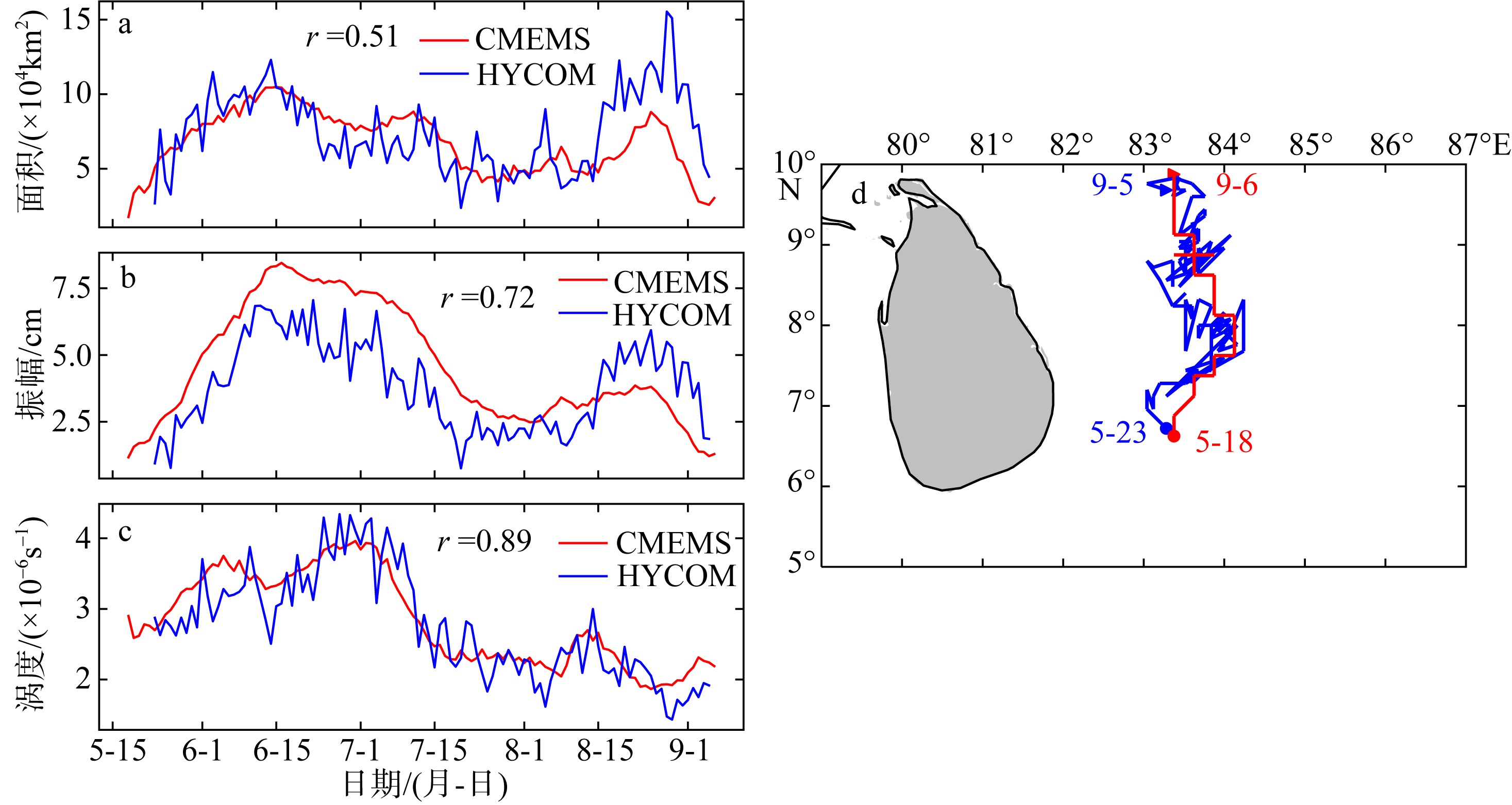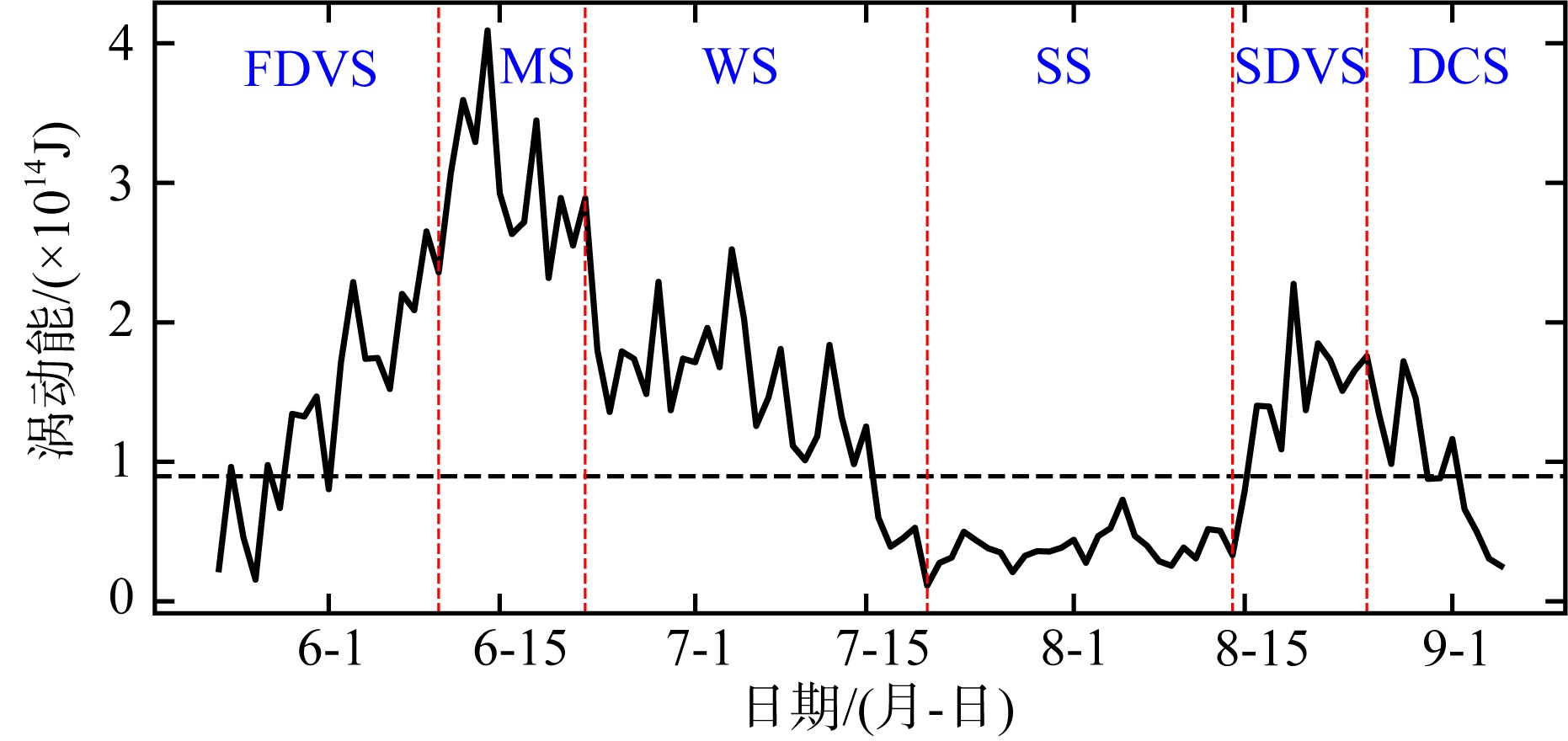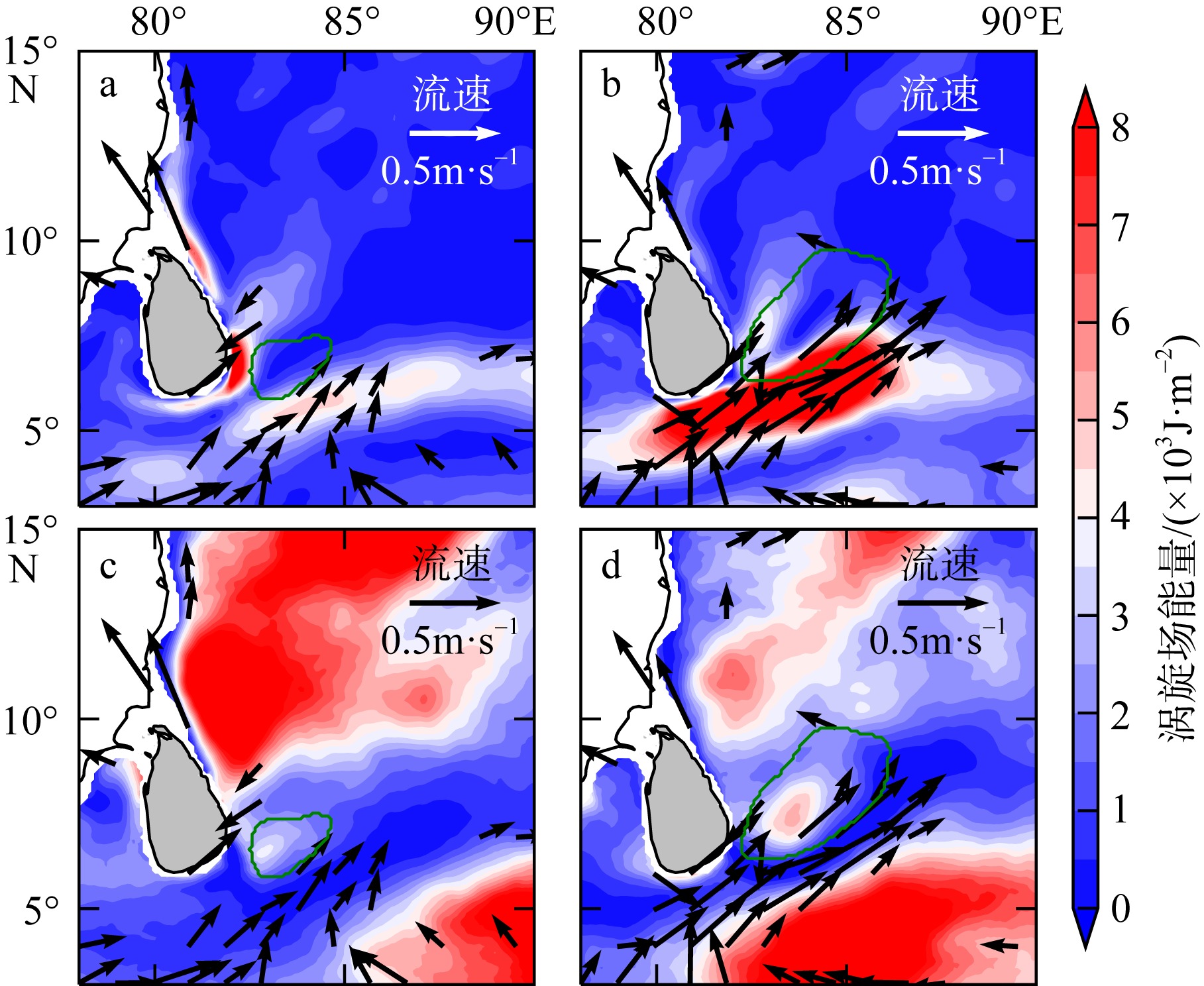Journal of Tropical Oceanography ›› 2023, Vol. 42 ›› Issue (5): 1-16.doi: 10.11978/2022260CSTR: 32234.14.2022260
Special Issue: 全球变化专题
• Marine Hydrology • Next Articles
The evolution and energy characteristics of the Sri Lanka Dome*
MA Yu1,2( ), WANG Weiqiang3,4(
), WANG Weiqiang3,4( ), YOU Qinglong1, XIN Hongyu5,6
), YOU Qinglong1, XIN Hongyu5,6
- 1. Department of Atmospheric and Oceanic Sciences, Fudan University, Shanghai 200438, China
2. East China Air Traffic Management Bureau of Civil Aviation Administration of China, Shanghai 200335, China
3. State Key Laboratory of Tropical Oceanography (South China Sea Institute of Oceanology, Chinese Academy of Sciences), Guangzhou 510301, China
4. Innovation Academy of South China Sea Ecology and Environmental Engineering, Chinese Academy of Sciences, Guangzhou 511458, China
5. Institute of Deep-sea Science and Engineering, Chinese Academic Science, Sanya 572000, China
6. University of Chinese Academy of Sciences, Beijing 100049, China
-
Received:2022-12-23Revised:2023-04-04Online:2023-09-10Published:2023-04-17 -
Supported by:National Key R&D Program of China(2022YFE0203500); National Natural Science Foundation of China(91958202); Development Fund of South China Sea Institute of Oceanology of the Chinese Academy of Sciences(SCSIO202201); Innovation Academy of South China Sea Ecology and Environmental Engineering, Chinese Academy of Sciences(ISEE2021ZD01)
Cite this article
MA Yu, WANG Weiqiang, YOU Qinglong, XIN Hongyu. The evolution and energy characteristics of the Sri Lanka Dome*[J].Journal of Tropical Oceanography, 2023, 42(5): 1-16.
share this article
Add to citation manager EndNote|Reference Manager|ProCite|BibTeX|RefWorks

Fig. 1
Averaged horizontal distribution of sea surface height anomalies (a, b, c) and surface geostrophic eddy kinetic energy (d, e, f) from May to October, 1994 to 2015. The averaged spatial distribution of sea surface height anomalies (a, b, c), obtained from CMEMS, HYCOM, and spatially filtered HYCOM data, respectively. The black arrows represent geostrophic current anomalies, while the shading represents the sea surface height anomalies. The averaged spatial distribution of surface geostrophic eddy kinetic energy (d, e, f) is also presented, generated from CMEMS, HYCOM, and spatially filtered HYCOM data, respectively. The shading represents surface geostrophic eddy kinetic energy"


Fig. 4
Time series of the SLD’s area (a), amplitude (b), vorticity (c), as well as its trajectory (d). The blue and red lines in d are the trajectories of the SLD identified by HYCOM and CMEMS, respectively. The blue and red dates are the generation and extinction times of the SLD. The CMEMS-found SLD first forms on May 18 and decays on September 6, and the HYCOM-found SLD first forms on May 23 and decays on September 5"


Fig. 6
The time series of volume-integrated (0~200 m) EKE in the SLD region. FDVS, MS, WS, SS, SDVS and DCS represent the first development stage, mature stage, weakening stage, stable stage, second development stage and decay stage of SLD, respectively. The black dashed line indicates the standard deviation of EKE, and the red dotted line indicates the dividing line between the stages"


Fig. 7
The vertical profiles of density anomaly along the longitude (a1~f1) and latitude (a2~f2) of the SLD’s center during the first development stage (a1~a2), mature stage (b1~b2), weakening stage (c1~c2), stable stage (d1~d2), second development stage (e1~e2) and decay stage (f1~f2) of the SLD. The mean values for the corresponding stages are shown, where the shading indicates density anomaly. The black contours indicate the zonal current anomaly (a1~f1) and meridional current anomaly (a2~f2) respectively, with a spacing of 0.1 m·s-1, the solid lines represent positive values, while the dashed lines represent negative values. The SLD region is shaded in gray"


Fig. 8
Spatial distribution of temperature (unit: ℃) and salinity (unit: ‰) in the first development stage (a1~a3), mature stage (b1~b3), weakening stage (c1~c3), stable stage (d1~d3), second development stage (e1~e3) and decay stage (f1~f3) of the SLD at depths of 10 m (a1~f1), 150 m (a2~f2) and 350 m (a3~f3), respectively. The mean values of the corresponding stages are shown in the figure, where the shading indicates temperature, the green closed contour indicates SLD, the red dots indicate the SLD centers, and the black contour is salinity. The thickened black contour at 10 m depth indicates a 34.4‰ salinity contour, and at 150 m depth, a 34.92‰ salinity contour"


Fig. 9
Spatial distribution of depth-integrated (0~200 m) EKE (a, b) and EPE (c, d) on May 23 (a, c) and June 10 (b, d). Green closed contours indicate SLD; black arrows indicate the geostrophic current, and only the part of the velocity greater than 0.2 m·s-1 is plotted in order to fully represent the major axis of SMC"


Fig. 10
Spatial distribution of depth-integrated (0~200 m) eddy energy: eddy kinetic energy (a1~f1) and eddy available potential energy (a2~f2), energy conversion rate: the wind stress work (a3~f3), the barotropic MKE→EKE conversion (a4~f4), the baroclinic MPE→EPE conversion (a5~f5), the baroclinic EPE→EKE conversion (a6~f6), the EKE advection (a7~f7), the EPE advection (a8~f8) and the pressure work (a9~f9) during the first development stage (a1~a9), mature stage (b1~b9), weakening stage (c1~c9), stable stage (d1~d9), second development stage (e1~e9) and decay stage (f1~f9) of the SLD, with green closed contours indicating SLD and black arrows for the geostrophic current"


Fig. 11
Vertical distribution of eddy energy: eddy kinetic energy (a1~a2) and eddy available potential energy (b1~b2), and energy conversion rate: the barotropic MKE→EKE conversion (c1~c2), the baroclinic MPE→EPE conversion (d1~d2), the baroclinic EPE→EKE conversion (e1~e2), the EKE advection (f1~f2), the EPE advection (g1~g2) and the pressure work (h1~h2) along the longitude (a1~f1) and latitude (a2~f2) of the SLD’s center at the mature stage of the SLD. The gray shaded area is the SLD region, and the thickened black contours indicate 5 J·m-3 and ±1 10-5 W·m-3, respectively, the solid lines represent positive values, while the dashed lines represent negative values"


Fig. 12
Spatial distribution of depth-integrated (0~200 m) EKE (a, b) and EPE (c, d) on August 26 (a, c) and September 5 (b, d). The closed green contours represent the SLD. The black arrows denote the geostrophic current. Only the part of the velocity greater than 0.2 m·s-1 is plotted in order to effectively depict the major axis of SMC"


Fig. 13
The comparison of volume-integrated (0~200 m) eddy energy (a) and energy conversion terms (b) in the SLD during the first development stage (FDVS), mature stage (MS), weakening stage (WS), stable stage (SS), second development stage (SDVS), and decay stage (DCS). EKE represents the eddy kinetic energy, EPE represents the eddy available potential energy, ${{\text{F}}_{\text{k}}}$ represents the wind stress work, BTC represents the barotropic MKE→EKE conversion, BCC represents the baroclinic MPE→EPE conversion, VEDF represents the baroclinic EPE→EKE conversion through vertical eddy density flux, $\text{AD}{{\text{V}}_{\text{k}}}$ represents the EKE advection, ADVp represents the EPE advection, and PW represents the pressure work"

| [1] |
杜岩, 张涟漪, 张玉红, 2019. 印度洋热带环流圈热盐输运及其对区域气候模态的影响[J]. 地球科学进展, 34(3): 243-254.
doi: 10.11867/j.issn.1001-8166.2019.03.0243 |
|
doi: 10.11867/j.issn.1001-8166.2019.03.0243 |
|
| [2] |
EKANAYAKA K B S S J, 王卫强, 2019. 斯里兰卡穹顶区的形成和演变机制分析[J]. 南京信息工程大学学报, 11(2): 198-207.
|
|
|
|
| [3] |
何蔚邦, 杨洋, 梁湘三, 2022. 斯里兰卡以东海域涡旋偶极子的生成与维持机制[J]. 海洋科学进展, 40(3): 379-398.
|
|
|
|
| [4] |
季页, 杨洋, 梁湘三, 2022. 孟加拉湾海域背景流-中尺度涡-高频扰动之间的相互作用[J]. 海洋学报, 44(9): 23-37.
|
|
|
|
| [5] |
乐洲, 黄科, MANTRAVADI V S, 2020. 2000—2015年夏秋季孟加拉湾湾口区涡流相互作用能量学特征[J]. 热带海洋学报, 39(2): 11-24.
doi: 10.11978/2019047 |
|
|
|
| [6] |
邱云, 李立, 周喜武, 2008. 斯里兰卡冷涡及其成因分析[J]. 热带海洋学报, 27(4): 45-51.
|
|
|
|
| [7] |
田永青, 邱云, 林新宇, 2022. 阿拉伯海高盐水入侵孟加拉湾的季节形态及动力机制[J]. 应用海洋学学报, 41(1): 100-108.
|
|
|
|
| [8] |
doi: 10.1002/jgrc.v122.9 |
| [9] |
doi: 10.1029/2018JG004446 |
| [10] |
doi: 10.1016/j.pocean.2011.01.002 |
| [11] |
doi: 10.1016/j.csr.2012.07.011 |
| [12] |
doi: 10.1002/jgrc.v123.3 |
| [13] |
doi: 10.1175/JPO-D-14-0009.1 |
| [14] |
doi: 10.1175/JPO-D-16-0012.1 |
| [15] |
doi: 10.1002/jgrc.20075 |
| [16] |
|
| [17] |
doi: 10.5194/bg-11-5909-2014 |
| [18] |
doi: 10.1038/sdata.2015.28 |
| [19] |
doi: 10.1007/s10872-017-0435-z |
| [20] |
doi: 10.1029/2021JC017459 |
| [21] |
doi: 10.5670/oceanog |
| [22] |
doi: 10.3390/rs14143239 |
| [23] |
doi: 10.1175/JTECH-D-14-00019.1 |
| [24] |
|
| [25] |
|
| [26] |
|
| [27] |
doi: 10.1080/01431161.2020.1727057 |
| [28] |
doi: 10.1029/2004GL020247 |
| [29] |
doi: 10.1175/JPO-D-14-0071.1 |
| [30] |
doi: 10.1007/s10236-019-01295-x |
| [31] |
doi: 10.1016/S0079-6611(01)00083-0 |
| [32] |
doi: 10.1029/2006GL027573 |
| [33] |
doi: 10.1016/S0079-6611(02)00024-1 |
| [34] |
doi: 10.1175/1520-0485(1990)020<1742:TMACIG>2.0.CO;2 |
| [35] |
|
| [36] |
doi: 10.1002/grl.50274 |
| [37] |
doi: 10.1175/1520-0485(1998)028<1946:MROTSA>2.0.CO;2 |
| [38] |
doi: 10.1175/JPO-D-17-0215.1 |
| [39] |
doi: 10.1175/JPO-D-16-0113.1 |
| [40] |
doi: 10.1175/JPO-D-18-0201.1 |
| [41] |
doi: 10.1175/JPO-D-21-0198.1 |
| [42] |
doi: 10.1002/jgrc.v118.9 |
| [43] |
doi: 10.1175/JPO-D-18-0058.1 |
| [44] |
|
| [1] | YANG Yikai, ZENG Lili. Spatiotemporal characteristics of mesoscale eddies with transport capability of saline Kuroshio water in the northern South China Sea [J]. Journal of Tropical Oceanography, 2023, 42(3): 75-85. |
| [2] | LIU Shuang, JING Zhiyou, ZHAN Haigang. Predicting the mesoscale eddy in the tropical and subtropical ocean based on generative adversarial network model [J]. Journal of Tropical Oceanography, 2022, 41(5): 1-16. |
| [3] | ZHANG Xu, JING Zhiyou, ZHENG Ruixi, HUANG Xiaolong, CAO Haijin. Submesoscale characteristics of a typical anticyclonic mesoscale eddy in Kuroshio Extension* [J]. Journal of Tropical Oceanography, 2021, 40(6): 31-40. |
| [4] | Xiaowen ZHOU, Haijin CAO, Zhiyou JING, Guanghong LIAO. Anisotropy of submesoscale eddy in Kuroshio Extension based on high resolution ROMS output analysis [J]. Journal of Tropical Oceanography, 2020, 39(3): 10-18. |
| [5] | Zhou LE, Ke HUANG, Subrahmanyam Mantravadi Venkata. Energy characteristics of eddy-mean flow interaction in the estuary of Bay of Bengal in summer and autumn during 2000-2015 [J]. Journal of Tropical Oceanography, 2020, 39(2): 11-14. |
| [6] | Xia WANG,Wendong FANG,Rongyu CHEN. Intra-seasonal variability of sea level anomalies and their propagation features in the northern South China Sea from 25 years of satellite altimetry data [J]. Journal of Tropical Oceanography, 2019, 38(3): 1-12. |
| [7] | HU Shuibo, CAO Wenxi, WANG Guifen, XU Zhantang. Using MODIS to track and monitor the impact of a cold eddy on the bio-optical parameters of surface waters* [J]. Journal of Tropical Oceanography, 2016, 35(3): 1-10. |
| [8] | TIAN Yongqing, HUANG Honghui, GONG Xiuyu, YU Shaomei. The formation mechanism of the low temperature and high salinity water mass near the Zhongsha Islands in the South China Sea in March 2014 [J]. Journal of Tropical Oceanography, 2016, 35(2): 1-9. |
| [9] | GENG Wu,HE Wei-hong,ZOU Xiao-li,XIE Qiang. A numerical study of effects due to mesoscale eddy induced by an idealized typhoon and the Kuroshio in the Luzon Strait [J]. Journal of Tropical Oceanography, 2013, 32(2): 66-73. |
| [10] | XU Chi, CHEN Gui-ying, SHANG Xiao-dong, HUANG Rui-xin. The spatial distribution of sources and sinks of ocean mesoscale eddies [J]. Journal of Tropical Oceanography, 2013, 32(2): 37-46. |
| [11] | WANG Xin, DU Yun-yan, ZHOU Cheng-hu, FAN Xing, YI Jia-wei. An improved, SSH-based method to automatically identify mesoscale eddies in the ocean [J]. Journal of Tropical Oceanography, 2013, 32(2): 15-23. |
| [12] | SHANG Xiao-dong, XU Chi, CHEN Gui-ying, LIAN Shu-min. Review on mechanical energy of ocean mesoscale eddies and associated energy sources and sinks [J]. Journal of Tropical Oceanography, 2013, 32(2): 24-36. |
| [13] | LIU Guang-ping,HU Jian-yu. A preliminary analysis of variation of the Kuroshio axis during tropical cyclone [J]. Journal of Tropical Oceanography, 2012, 31(1): 35-41. |
|
||







